Observational and Numerical Study of the Vertical Structure of Anticyclonic Eddy in Northern South China Sea and Its Response to Typhoon
Abstract
1. Introduction
2. Materials and Methods
2.1. Underwater Glider Data
2.2. Satellite Altimeter Data
2.3. Typhoon Information
2.4. Mesoscale Eddy Identification Method
2.5. Numerical Model Configuration
2.6. Numerical Experiment Design
3. Results and Discussion
3.1. Evolution Analysis of the AE in the Northern SCS Based on Satellite Altimeter Data
3.2. Vertical Thermohaline Analysis of Mesoscale Eddy Based on Underwater Glider Observations
3.3. Vertical Structural Changes of the Mesoscale Eddy Under Typhoon Influence
3.3.1. Typhoon-Induced Thermohaline Variations Revealed by Underwater Gliders
3.3.2. Validation of Numerical Simulation Results
3.3.3. Typhoon Impacts on the Vertical Structure of the Anticyclonic Eddy: Numerical Evidence
4. Conclusions
Supplementary Materials
Author Contributions
Funding
Data Availability Statement
Acknowledgments
Conflicts of Interest
References
- Chelton, D.B.; Schlax, M.G.; Samelson, R.M. Global observations of nonlinear mesoscale eddies. J. Prog. Oceanogr. 2011, 91, 167–216. [Google Scholar] [CrossRef]
- Yang, Y.; Wang, D.; Wang, Q.; Zeng, L.; Xing, T.; He, Y.; Shu, Y.; Chen, J.; Wang, Y. Eddy-Induced Transport of Saline Kuroshio Water Into the Northern South China Sea. J. Geophys. Res. Ocean. 2019, 124, 6673–6687. [Google Scholar] [CrossRef]
- Ma, Z.; Fei, J.; Liu, L.; Huang, X.; Li, Y. An Investigation of the Influences of Mesoscale Ocean Eddies on Tropical Cyclone Intensities. J. Mon. Weather Rev. 2017, 145, 1181–1201. [Google Scholar] [CrossRef]
- Lin, X.; Dong, C.; Chen, D.; Liu, Y.; Yang, J.; Zou, B.; Guan, Y. Three-dimensional properties of mesoscale eddies in the South China Sea based on eddy-resolving model output. Deep Sea Res. Part I Oceanogr. Res. Pap. 2015, 99, 46–64. [Google Scholar] [CrossRef]
- Wang, G.; Su, J.; Chu, P.C. Mesoscale eddies in the South China Sea observed with altimeter data. Geophys. Res. Lett. 2003, 30, 2121. [Google Scholar] [CrossRef]
- Xing, T.; Yang, Y. Three Mesoscale Eddy Detection and Tracking Methods: Assessment for the South China Sea. J. Atmos. Ocean. Technol. 2021, 38, 243–258. [Google Scholar] [CrossRef]
- Martin, J.P.; Lee, C.M.; Eriksen, C.C.; Ladd, C.; Kachel, N.B. Glider observations of kinematics in a Gulf of Alaska eddy. J. Geophys. Res. Ocean. 2009, 114, C12021. [Google Scholar] [CrossRef]
- Qiu, C.; Mao, H.; Wang, Y.; Yu, J.; Su, D.; Lian, S. An irregularly shaped warm eddy observed by Chinese underwater gliders. J. Oceanogr. 2018, 75, 139–148. [Google Scholar] [CrossRef]
- Shu, Y.; Chen, J.; Li, S.; Wang, Q.; Yu, J.; Wang, D. Field-observation for an anticyclonic mesoscale eddy consisted of twelve gliders and sixty-two expendable probes in the northern South China Sea during summer 2017. Sci. China Earth Sci. 2018, 62, 451–458. [Google Scholar] [CrossRef]
- Qiu, C.; Mao, H.; Liu, H.; Xie, Q.; Yu, J.; Su, D.; Ouyang, J.; Lian, S. Deformation of a Warm Eddy in the Northern South China Sea. J. Geophys. Res. Ocean. 2019, 124, 5551–5564. [Google Scholar] [CrossRef]
- Li, S.; Wang, S.; Zhang, F.; Wang, Y. Constructing the Three-Dimensional Structure of an Anticyclonic Eddy in the South China Sea Using Multiple Underwater Gliders. J. Atmos. Ocean. Technol. 2019, 36, 2449–2470. [Google Scholar] [CrossRef]
- Zhang, H.; He, H.; Zhang, W.-Z.; Tian, D. Upper ocean response to tropical cyclones: A review. J. Geosci. Lett. 2021, 8, 1. [Google Scholar] [CrossRef]
- Hiroshi, K. Detection of cyclonic eddy generated by looping tropical cyclone in the northern South China Sea: A case study. J. Oceanogr. 2004, 2, 213–224. [Google Scholar]
- Ma, Z.; Zhang, Z.; Fei, J.; Wang, H. Imprints of Tropical Cyclones on Structural Characteristics of Mesoscale Oceanic Eddies Over the Western North Pacific. Geophys. Res. Lett. 2021, 48, e2021GL092601. [Google Scholar] [CrossRef]
- Huang, X.; Wang, G. Response of a Mesoscale Dipole Eddy to the Passage of a Tropical Cyclone: A Case Study Using Satellite Observations and Numerical Modeling. Remote Sens. 2022, 14, 2865. [Google Scholar] [CrossRef]
- Sun, L.; Li, Y.X.; Yang, Y.J.; Wu, Q.; Chen, X.T.; Li, Q.Y.; Li, Y.B.; Xian, T. Effects of super typhoons on cyclonic ocean eddies in the western North Pacific: A satellite data-based evaluation between 2000 and 2008. J. Geophys. Res. Ocean. 2014, 119, 5585–5598. [Google Scholar] [CrossRef]
- Lu, Z.; Wang, G.; Shang, X. Response of a Preexisting Cyclonic Ocean Eddy to a Typhoon. J. Phys. Oceanogr. 2016, 46, 2403–2410. [Google Scholar] [CrossRef]
- Walker, N.D.; Leben, R.R.; Balasubramanian, S. Hurricane-forced upwelling and chlorophyll a enhancement within cold-core cyclones in the Gulf of Mexico. Geophys. Res. Lett. 2005, 32, L18610. [Google Scholar] [CrossRef]
- Rudzin, J.E.; Chen, S. On the dynamics of the eradication of a warm core mesoscale eddy after the passage of Hurricane Irma (2017). Dyn. Atmos. Ocean. 2022, 100, 101334. [Google Scholar] [CrossRef]
- Cai, S.; Xu, J.; Wang, W.; Jing, C.; Li, K.; Zhang, J.; Kuang, F. Impacts of Typhoons on the Evolution of Surface Anticyclonic Eddies into Subsurface Anticyclonic Eddies in the Northwestern Subtropical Pacific Ocean. Remote Sens. 2024, 16, 4282. [Google Scholar] [CrossRef]
- Liu, X.; Sun, C.; Zuo, J. The Interactions Between Ocean and Three Consecutive Typhoons Affecting Northeast Asia in 2020 From a Model Perspective. J. Geophys. Res. Atmos. 2023, 128, e2022JD036442. [Google Scholar] [CrossRef]
- Liu, S.S.; Sun, L.; Wu, Q.; Yang, Y.J. The responses of cyclonic and anticyclonic eddies to typhoon forcing: The vertical temperature-salinity structure changes associated with the horizontal convergence/divergence. J. Geophys. Res. Ocean. 2017, 122, 4974–4989. [Google Scholar] [CrossRef]
- He, Y.; Lin, X.; Han, G.; Liu, Y.; Zhang, H. The different dynamic influences of Typhoon Kalmaegi on two pre-existing anticyclonic ocean eddies. Ocean Sci. 2024, 20, 621–637. [Google Scholar] [CrossRef]
- Li, S.; Zhang, F.; Wang, S.; Wang, Y.; Yang, S. Constructing the three-dimensional structure of an anticyclonic eddy with the optimal configuration of an underwater glider network. Appl. Ocean Res. 2020, 95, 101893. [Google Scholar] [CrossRef]
- Sadarjoen, I.A.; Post, F.H. Detection, quantification, and tracking of vortices using streamline geometry. J. Comput. Graph. 2000, 24, 333–341. [Google Scholar] [CrossRef]
- Chen, G.; Hou, Y.; Chu, X. Mesoscale eddies in the South China Sea: Mean properties, spatiotemporal variability, and impact on thermohaline structure. J. Geophys. Res. Ocean. 2011, 116, C06018. [Google Scholar] [CrossRef]
- Shchepetkin, A.F.; McWilliams, J.C. The regional oceanic modeling system (ROMS): A split-explicit, free-surface, topography-following-coordinate oceanic model. J. Ocean Model. 2005, 9, 347–404. [Google Scholar] [CrossRef]
- Umlauf, L.; Burchard, H. A generic length-scale equation for geophysical turbulence models. J. Mar. Res. 2003, 61, 235–265. [Google Scholar] [CrossRef]
- Warner, J.C.; Sherwood, C.R.; Arango, H.G.; Signell, R.P. Performance of four turbulence closure models implemented using a generic length scale method. J. Ocean Model. 2005, 8, 81–113. [Google Scholar] [CrossRef]
- Orton, P.; Georgas, N.; Blumberg, A.; Pullen, J. Detailed modeling of recent severe storm tides in estuaries of the New York City region. J. Geophys. Res.Ocean. 2012, 117, C09030. [Google Scholar] [CrossRef]
- Shu, Y.; Xiu, P.; Xue, H.; Yao, J.; Yu, J. Glider-observed anticyclonic eddy in northern South China Sea. Aquat. Ecosyst. Health Manag. 2016, 19, 233–241. [Google Scholar] [CrossRef]
- Ni, X.; Zhang, Y.; Wang, W. Hurricane influence on the oceanic eddies in the Gulf Stream region. Nat. Commun. 2025, 16, 583. [Google Scholar] [CrossRef] [PubMed]
- Zhu, X.; Guo, S.; Chang, J.; Zhang, X.; Hu, Z.; Wang, H. Full destruction of an anticyclonic eddy in the Northern South China Sea by Tropical Storm Mulan. Deep Sea Res. Part I Oceanogr. Res. Pap. 2025, 220, 104500. [Google Scholar] [CrossRef]

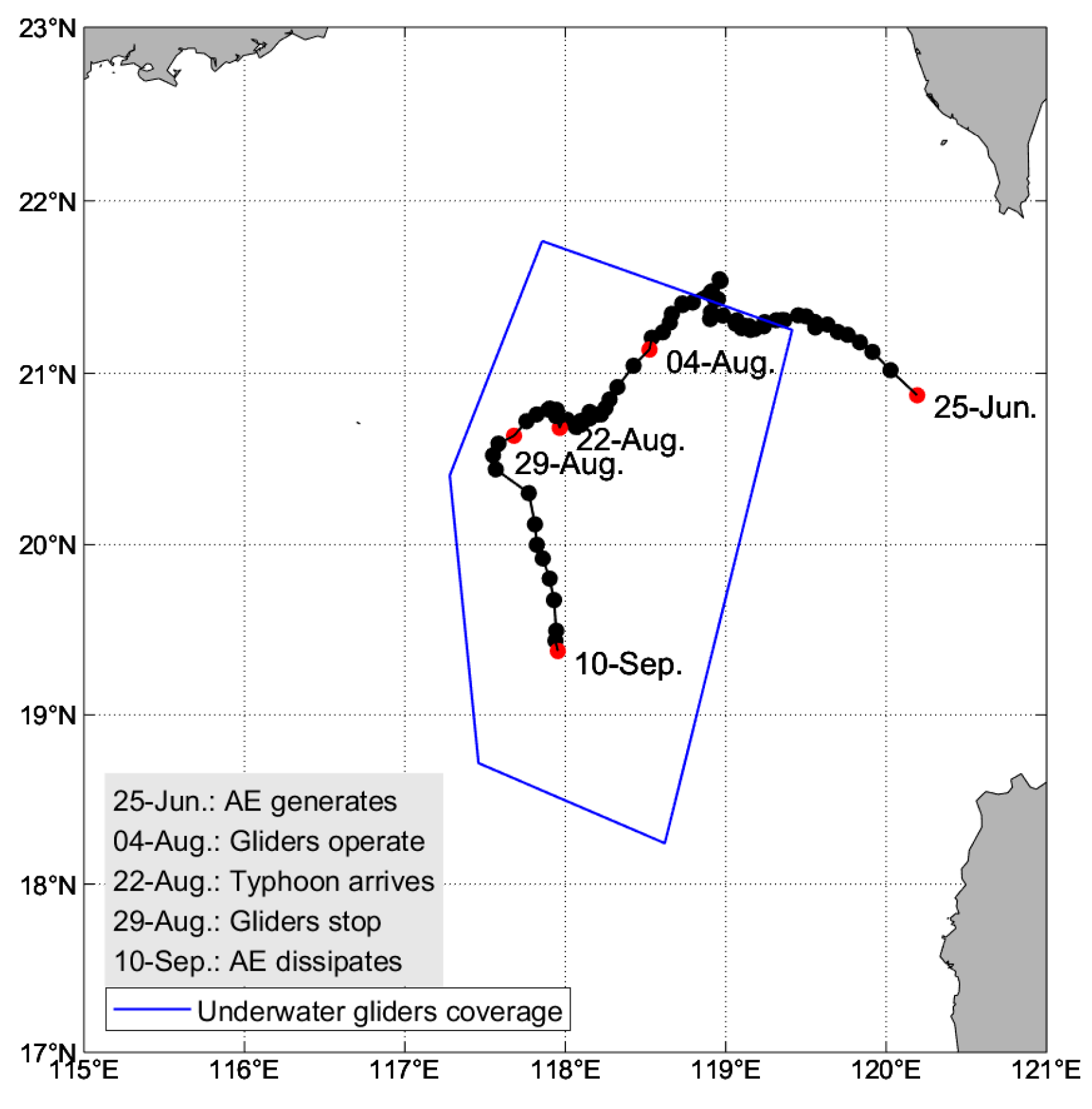



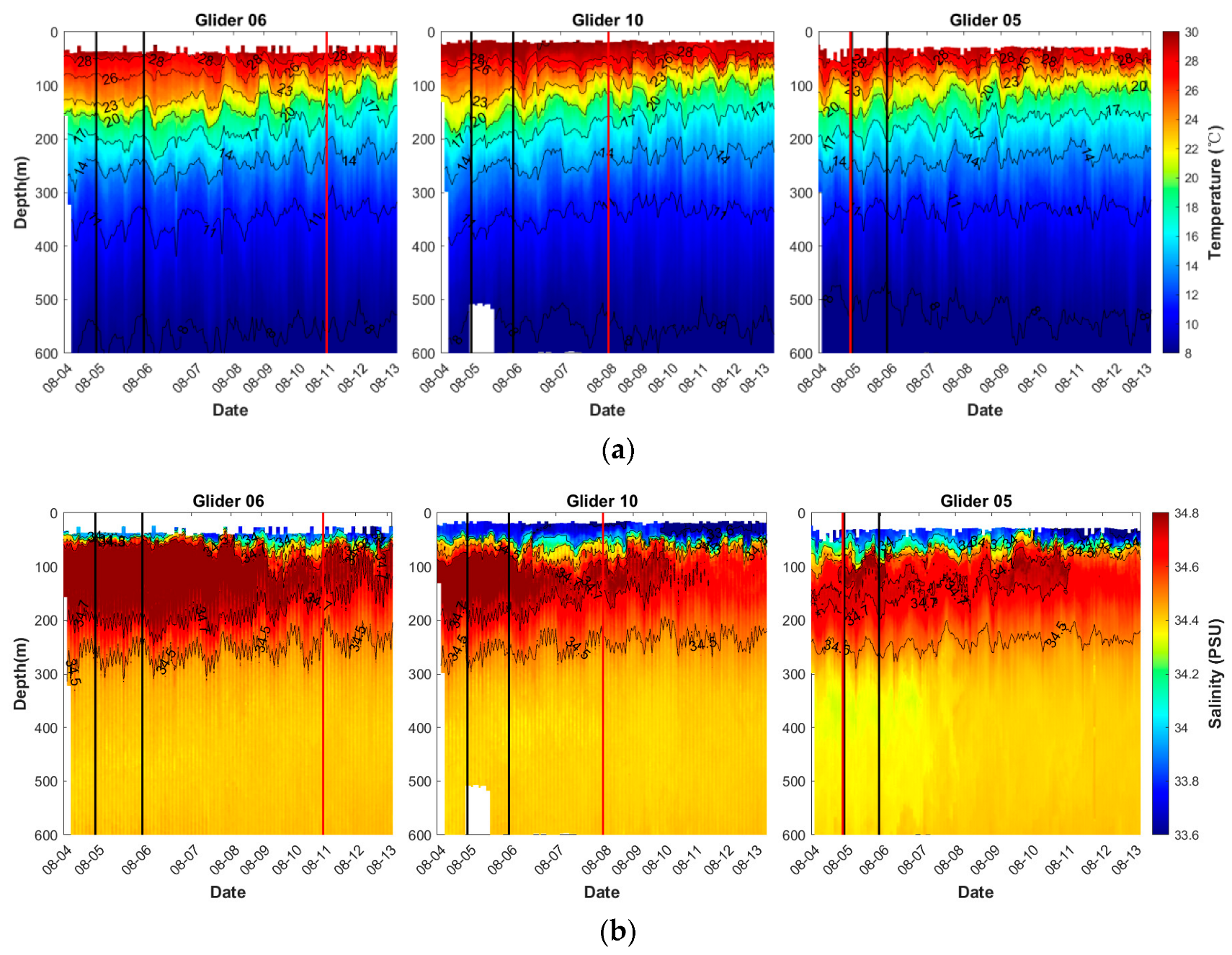
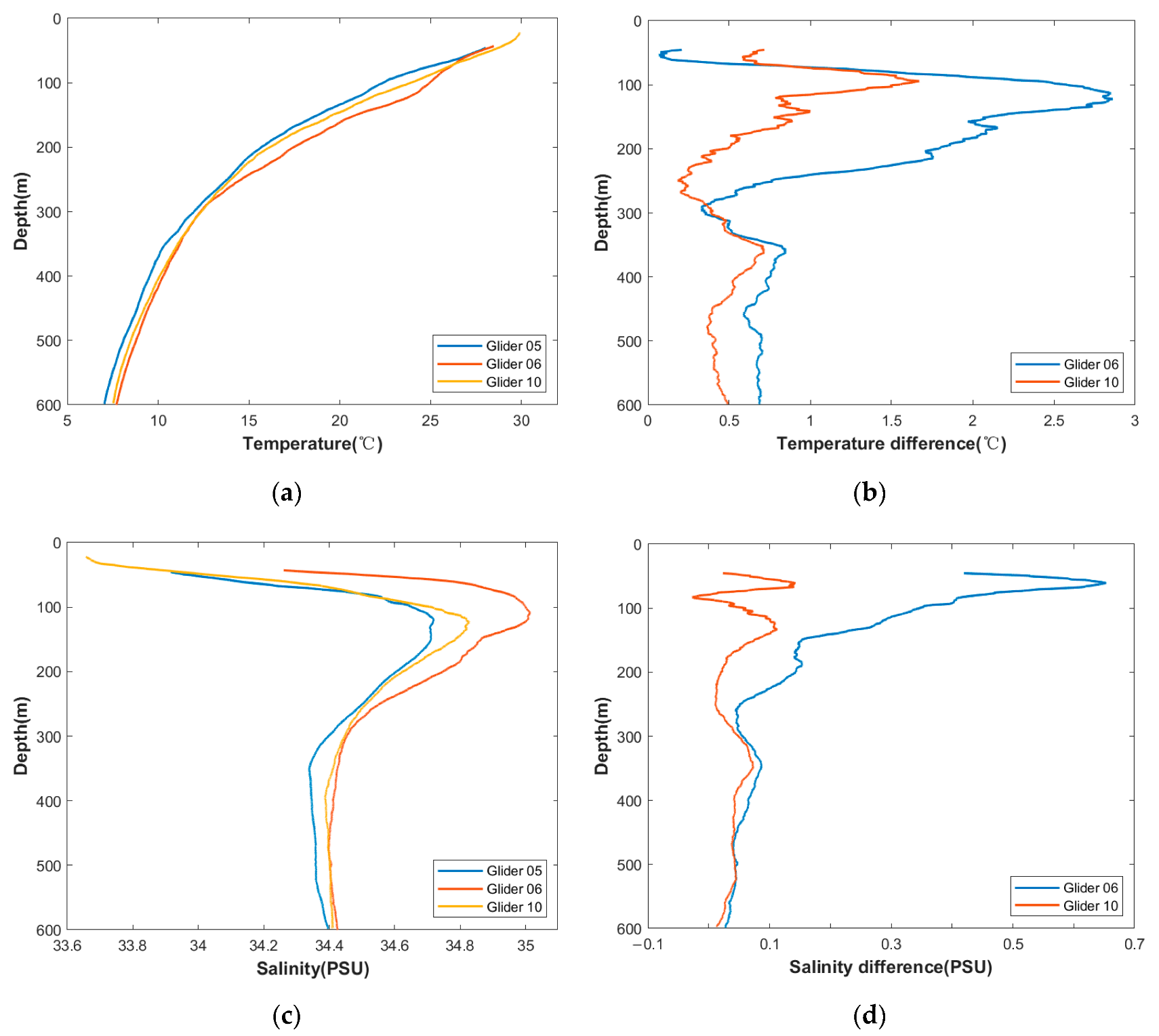

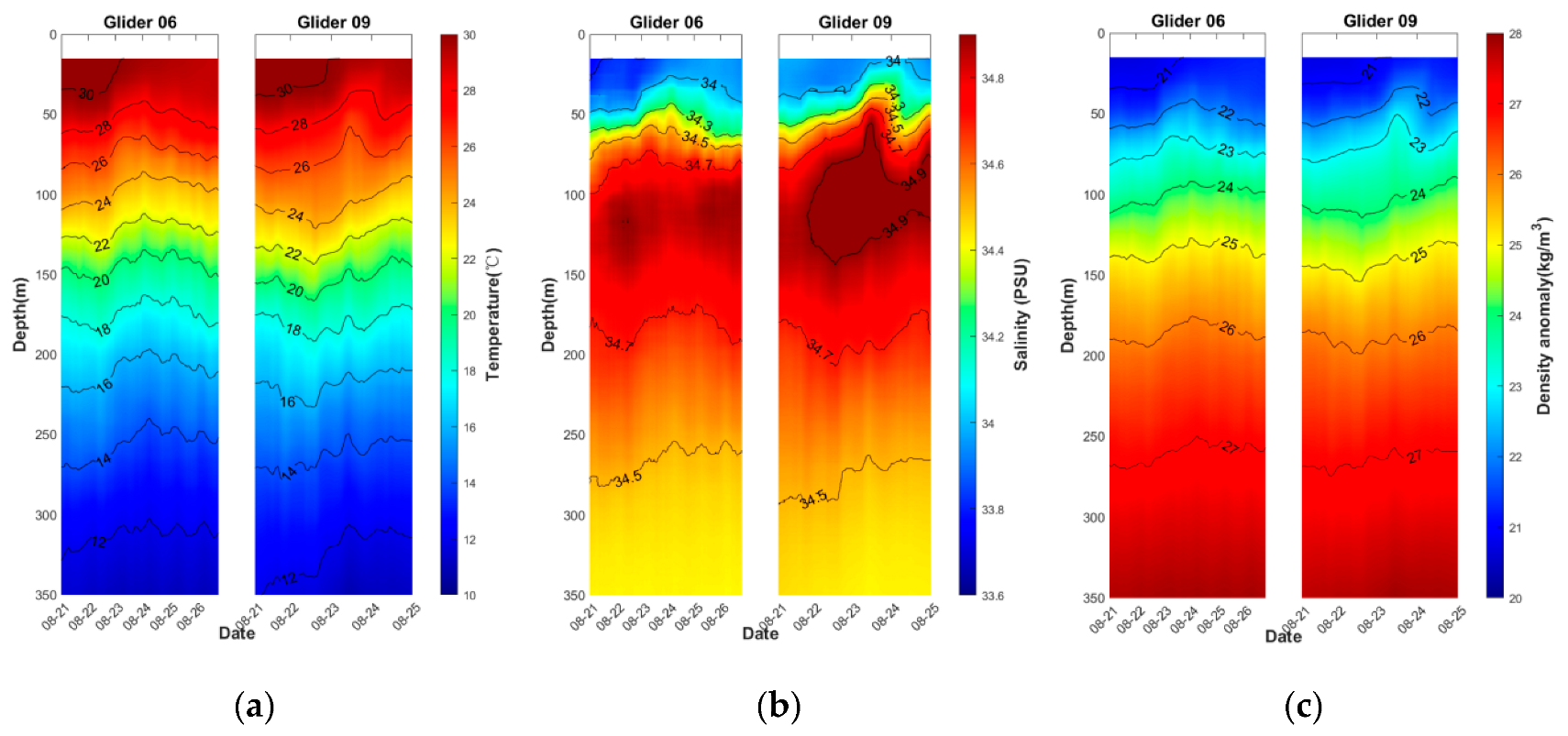
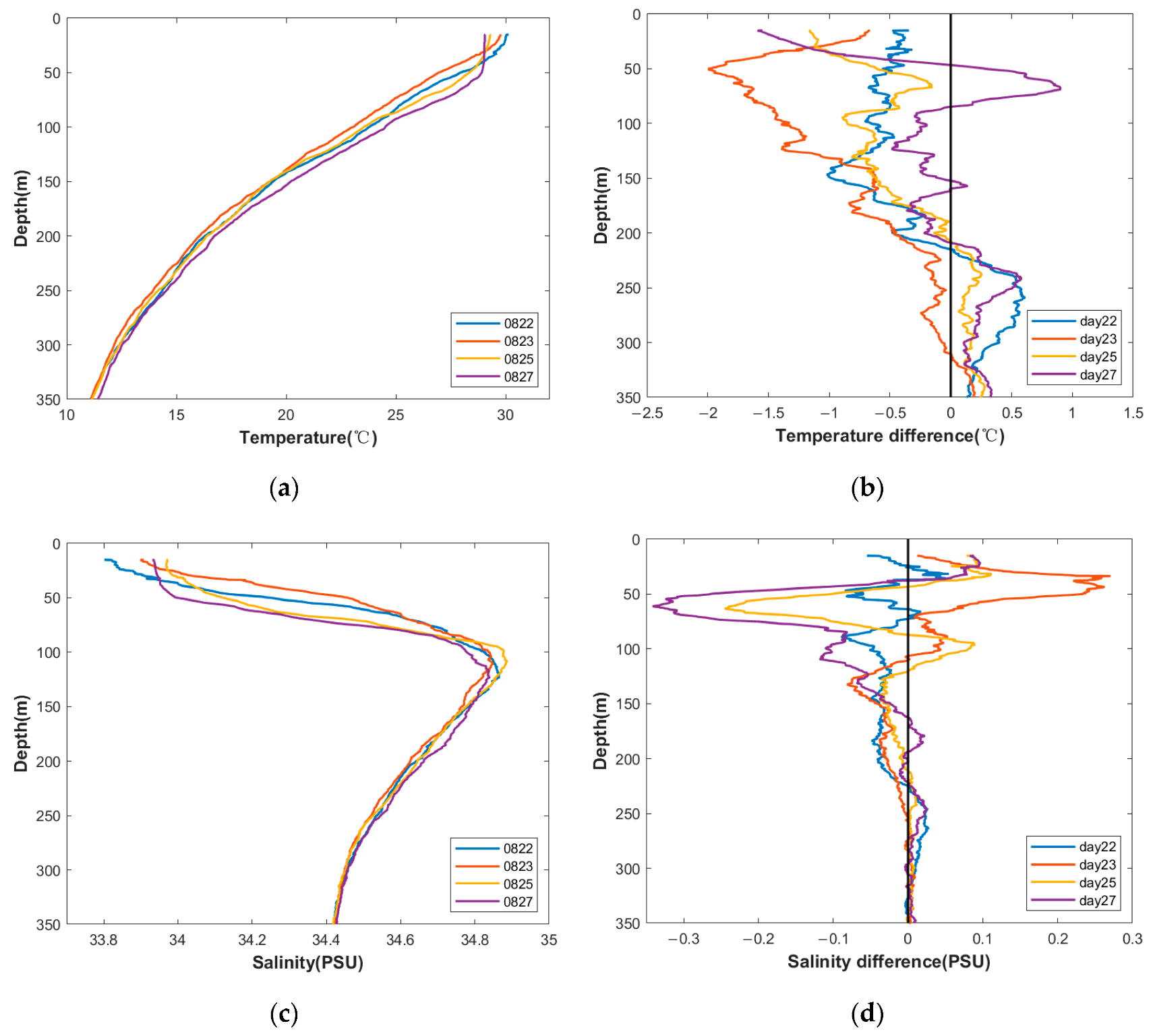
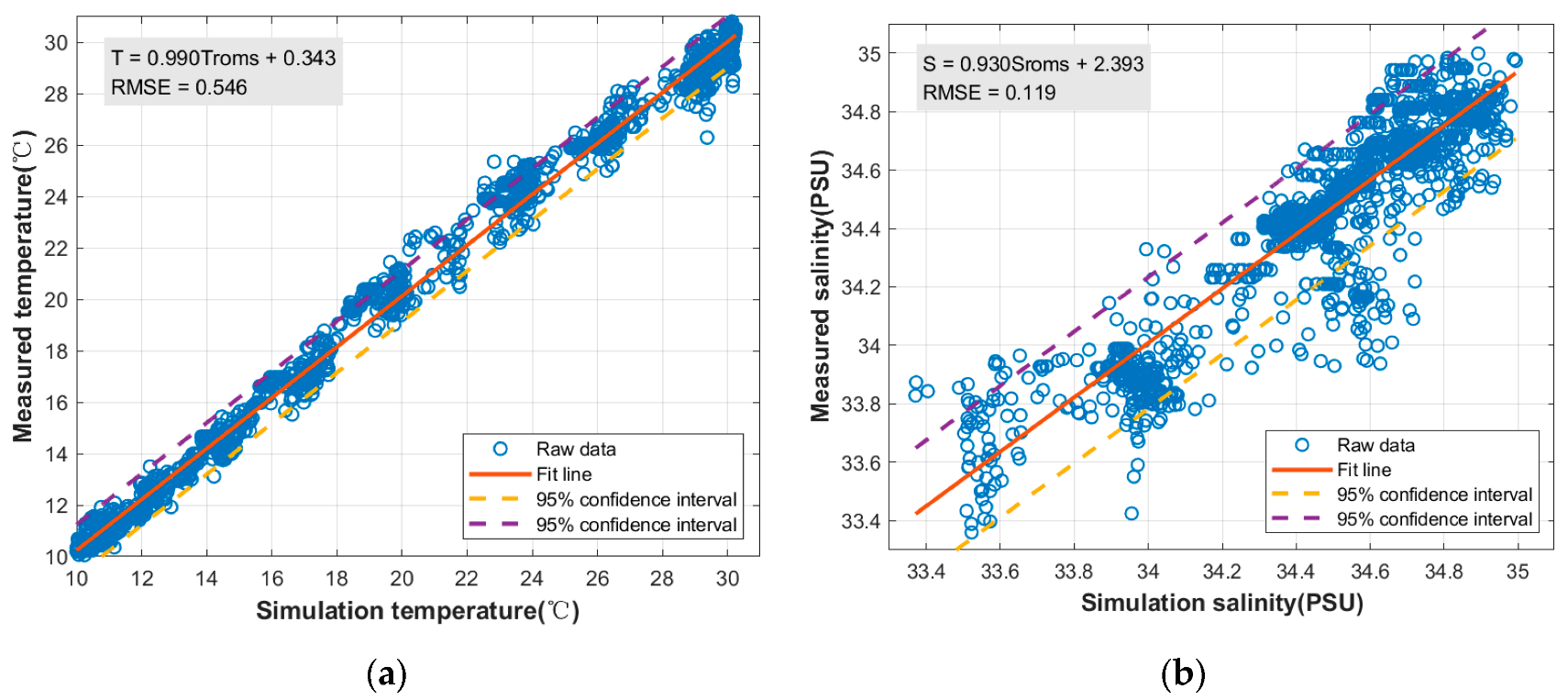
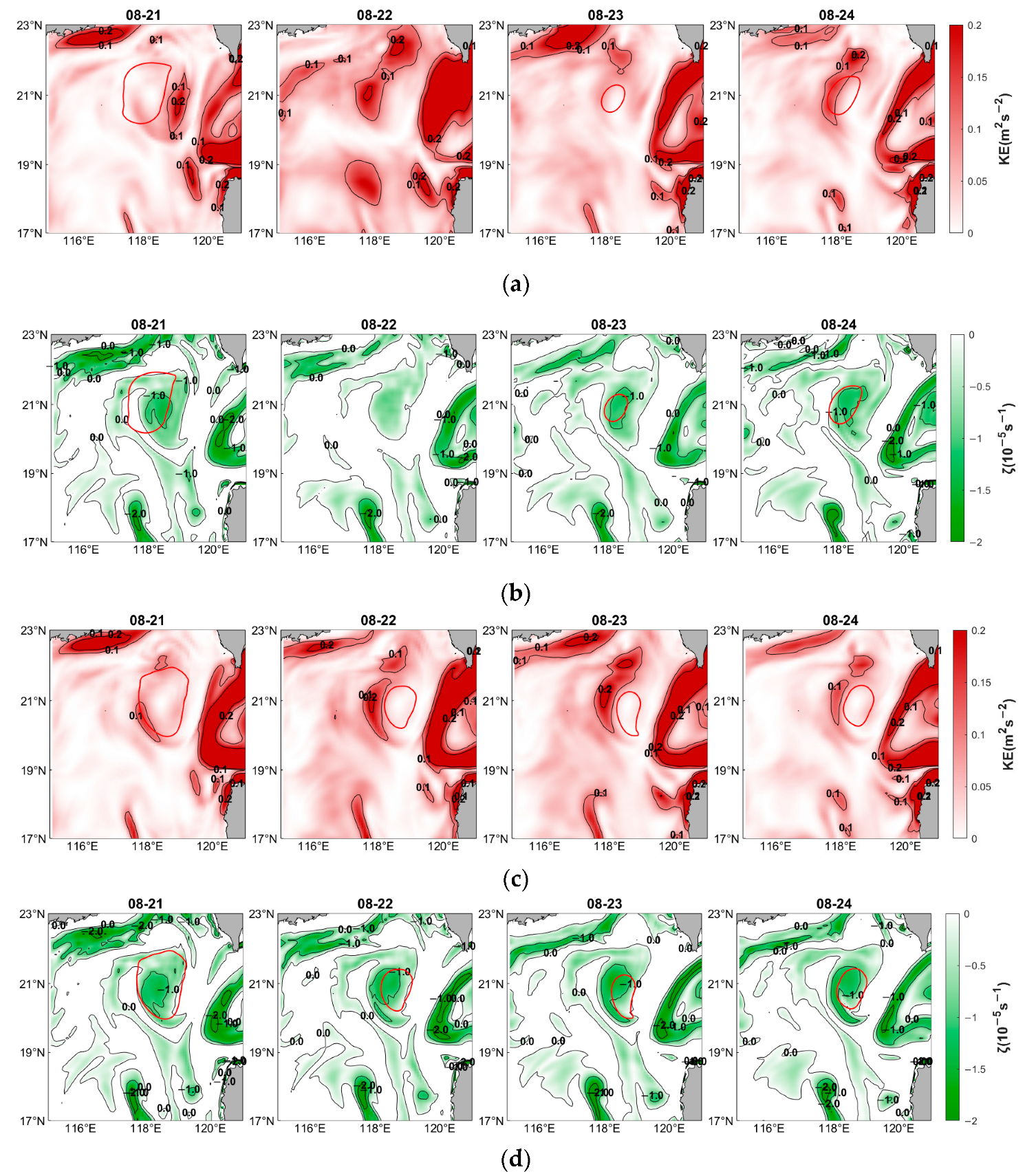


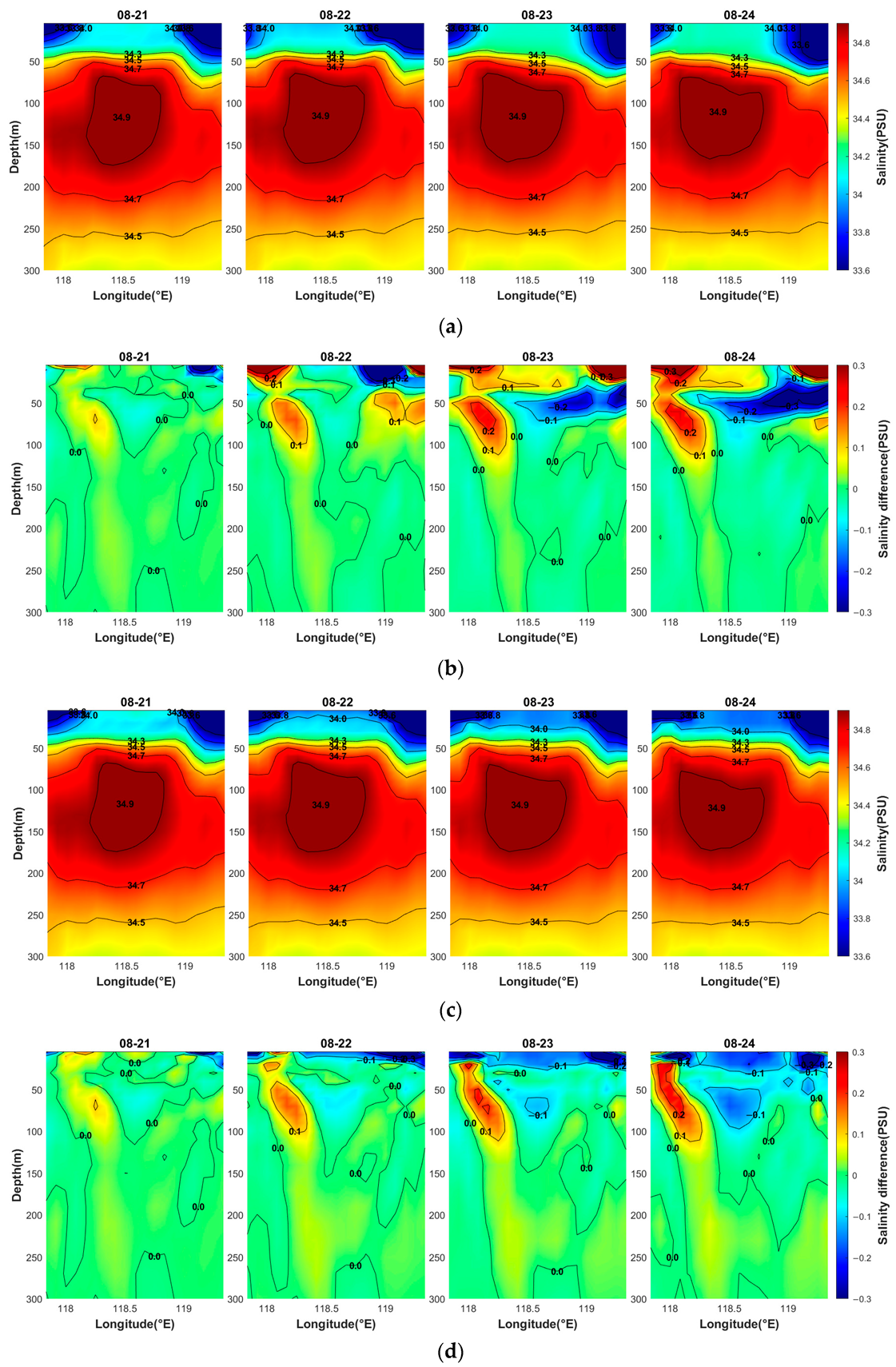
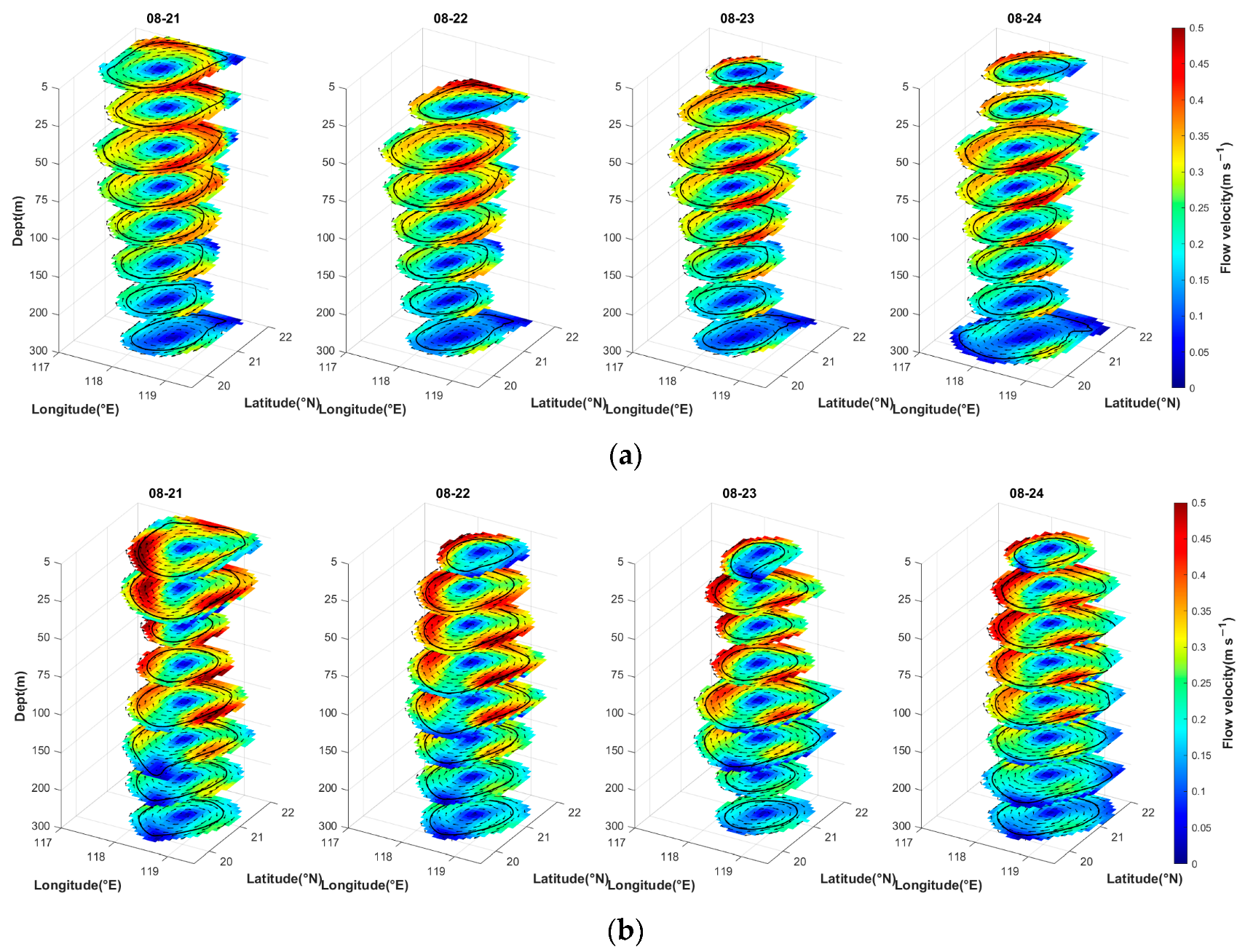
| Glider ID | Distance from Eddy Center (km) | Relative Position |
|---|---|---|
| 05 | 78.5 | Eddy boundary |
| 06 | 9.8 | Near eddy core |
| 10 | 46.7 | Intermediate transition zone |
| Glider Pair | Max ΔT (°C) | Depth (m) | Max ΔS (PSU) | Depth (m) |
|---|---|---|---|---|
| Glider 06 vs. 05 | 2.86 | 122 | 0.65 | 61 |
| Glider 10 vs. 05 | 1.67 | 94 | 0.14 | 61 |
| Glider Pair | Max ΔT (°C) | Depth (m) | Max ΔS (PSU) | Depth (m) |
|---|---|---|---|---|
| Glider 06 vs. 05 | 0.85 | 358 | 0.09 | 350 |
| Glider 10 vs. 05 | 0.72 | 361 | 0.07 | 347 |
| Date | 08-21 | 08-22 | 08-23 | 08-24 |
|---|---|---|---|---|
| (TC) Max ΔT (°C) | 0.31 | 1.15 | 1.22 | 1.68 |
| (TC) Depth (m) | 70 | 60 | 60 | 70 |
| (No TC) Max ΔT (°C) | 0.25 | 0.36 | 0.51 | 0.66 |
| (No TC) Depth (m) | 50 | 70 | 60 | 50 |
Disclaimer/Publisher’s Note: The statements, opinions and data contained in all publications are solely those of the individual author(s) and contributor(s) and not of MDPI and/or the editor(s). MDPI and/or the editor(s) disclaim responsibility for any injury to people or property resulting from any ideas, methods, instructions or products referred to in the content. |
© 2025 by the authors. Licensee MDPI, Basel, Switzerland. This article is an open access article distributed under the terms and conditions of the Creative Commons Attribution (CC BY) license (https://creativecommons.org/licenses/by/4.0/).
Share and Cite
Ma, W.; Zhang, W.; Zhu, S. Observational and Numerical Study of the Vertical Structure of Anticyclonic Eddy in Northern South China Sea and Its Response to Typhoon. J. Mar. Sci. Eng. 2025, 13, 1646. https://doi.org/10.3390/jmse13091646
Ma W, Zhang W, Zhu S. Observational and Numerical Study of the Vertical Structure of Anticyclonic Eddy in Northern South China Sea and Its Response to Typhoon. Journal of Marine Science and Engineering. 2025; 13(9):1646. https://doi.org/10.3390/jmse13091646
Chicago/Turabian StyleMa, Weijie, Wenjing Zhang, and Shouxian Zhu. 2025. "Observational and Numerical Study of the Vertical Structure of Anticyclonic Eddy in Northern South China Sea and Its Response to Typhoon" Journal of Marine Science and Engineering 13, no. 9: 1646. https://doi.org/10.3390/jmse13091646
APA StyleMa, W., Zhang, W., & Zhu, S. (2025). Observational and Numerical Study of the Vertical Structure of Anticyclonic Eddy in Northern South China Sea and Its Response to Typhoon. Journal of Marine Science and Engineering, 13(9), 1646. https://doi.org/10.3390/jmse13091646





